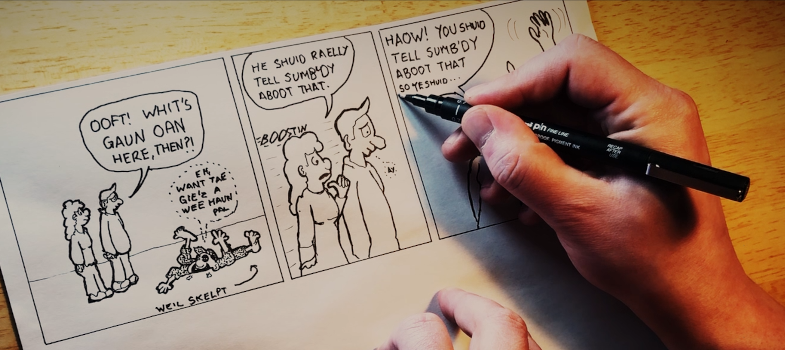Scots as a language learning option in schools

© Michael Dempster
2. Input
2.4. Activity 5
Although Scots is classed as a non-standard language, this does not mean there are no rules for using it. For example, when it comes to spelling, there are rules which can help you build confidence in reading and writing in Scots.
As you might have discovered in the three parts of Activity 4, there is a close link between spelling and pronunciation which helps develop your mastery of the rules for writing in Scots. For example, lesson 1 of the ‘Engaging with spelling in Scots language’ highlighted the phonetic approach to spelling in Scots. This is the same approach used in the German language, where words are mostly written as they are pronounced, as showcased in some of the language links (Introductory handsel) in the Open University Scots language and culture course.
This activity is designed to help you create classroom activities based on the information on Scots spelling you will study.
A.
When exploring Scots as a language it is useful to begin at the level of vocabulary.
Often people’s conception of what Scots is, are the words which are perceived as being unique to Scots. Take some time to note down as many unique Scots words as you can think of. There are many thousands of these in common usage. When exploring uniquely Scots words it is useful to consider if these are words specific to a dialect or if they are used in other dialects of Scots. And to go one step further, you might be able to identify, if they exist in other dialects, how do they vary in pronunciation and spelling.
Example: fankle or fangle (verb or noun, see the DSL for various nuances in meaning: to trap, to tangle, to stumble; a tangle/muddle)
You may like to do this activity in your own class.
Start by asking the pupils for a Scots word they know, then discuss how this could be spelled. In this discussion, think again about the question from Michael’s video: How can I write a Scots word so that others can say/read/understand it/Hou dae A best write sae thit fowk ken hou tae read oot whit it is that A’m writin? Also remember the links you have made between spelling and pronunciation in Activity 4. To help you with this activity, explore the list of Words unique to Scots Michael has collated in his own teaching.
As a second step, you can work with a dictionary to ascertain whether the spelling convention you have come up with is commonly used, and whether the meaning of the word you had in mind coincides with that listed in the dictionary. Use the Dictionary of the Scots Language, both the full online version and the Scots Dictionary for Schools App.
As a final step, think of a way in which pupils can then use these uniquely Scots words in writing, depending on your own teaching context. Then bring your word(s) and activity idea to the Unit 7 tutorial.
B.
A second class of words to consider are those which are related to English words but vary in one or more consonant or vowel sounds. Take some time to note down as many of these as you can think of.
Examples: scoor (Sc.) – scour (Eng.); soond (Sc.) – sound (Eng.)
You could again develop an activity around this for your own teaching.
Study the list of Words with the same meaning but different spelling/pronunciation in Scots and English provided by Michael to raise awareness of spelling patterns in Scots and English and differences between both that are common. Pupils might even realise that they might have been spelling words in Scots rather than making mistakes in English spelling! By being aware of such common patterns, pupils will have more knowledge to draw on and become more confident in their own work.
Discuss with your pupils good ways of remembering these patterns such as:
Example: oo (Sc.) vs. ow/ ou (Eng.)
Pupils could create posters for display in the classroom, start developing a rule book or other ways to help remembering through visualisation.
Finally, think again of an activity in which pupils use these words, for example writing the same text in Scots and English using such words and bring your idea to the tutorial.
